The ADA Didn't Save Lois... and #FreeOurPeople Didn't, Either
- Lois Curtis Center

- Jul 20
- 4 min read
Because anyone, theoretically, can join the disability community (population: 56 million-plus in the US) at any time, we at Lois Curtis Center wish to recognize the thirty-fifth anniversary of the Americans with Disabilities Act (ADA) by doing what we do on a daily basis: highlighting the inclusion gaps that are present in disability rights initiatives (such as the ADA) that facilitate the systemic exclusion of Black and Brown disabled people from the disability community and, as a result, leave them hidden in the plain sight of mainstream society.
This exclusion is no more apparent than when it comes to Home and Community Based Services (HCBS), the primary funding mechanism for disability services and supports in the US that, unfortunately, only 5-10% of the disability population enjoys access to.
It is this 5-10% of the disability community that the ADA was primarily crafted for.
People with disabilities who would benefit, but are either barred from access to or not eligible for disability services such as HCBS can experience a variety of negative outcomes, including higher rates of child maltreatment, incarceration, exploitation, mental health issues, substance abuse issues, legal hurdles, chronic health problems, criminalization, and isolation.
And, despite the correlation between barriers to access to/eligibility for HCBS and the aforementioned maladies, because the barriers typically pertain to systemic racism within #BigDisCo and not disability itself, the ADA offers no relief here to those impacted.
Unpacking Barriers to Accessing HCBS Rooted in #BigDisCo's Systemic Racism
HCBS is Medicaid.
Although Black people utilize Medicaid at three times the rate of white people, they experience significant systemic barriers to accessing the HCBS manifestation of Medicaid due to a variety of factors, including long waiting lists, reticence on the part of disability service providers to work in “urban” areas, and the unnecessarily complex and secretive application process itself. Because HCBS funding is the primary revenue stream for the disability service providers of #BigDisCo, they are the key players when it comes to disability advocacy at the state and federal level, where their advocacy efforts are inexorably linked to their efforts to ensure that they continue to received funding. As a result, center their consumer base, not the disability community as a whole, in their efforts.
The ADA Avoids the Intersection of Systemic Racism and Disability
Trauma causes disability.
Trauma exacerbates disability.
And many Black and Brown people who find themselves at the intersection of systemic racism and trauma find themselves facing a door to the disability community that is seemingly locked shut. This exclusion has led to the significant skewing of understanding regarding the disability experience that is at the core of disability research, policy, legislation, service provision, and advocacy. It ensures that Black and Brown people with disabilities, particularly those grappling with cPTSD and/or other trauma-induced disabilities, are woefully pathologized and criminalized by #BigDisCo and society, as a whole. The preschool to prison pipeline, police violence, and exploitative prison subminimum wage practices are, therefore, disability issues, whether decisionmakers within #BigDisCo want to acknowledge them or not as such.
(They don’t)
The ADA Won’t Save US
FACT: The ADA only requires protections in ENGLISH or American Sign Language (ASL).
FACT: The ADA only addresses disability-based barriers to access in public spaces. It does NOTHING to address barriers to access of disability services and supports themselves that are rooted in systemic racism.
FACT: The ADA is NOT intersectional.
FACT: The ADA, like all other disability legislation, was written by straight cis white people, under the advisement of white disability professionals- mostly nondisabled white, cis, straight, male disability professionals who have some adjacency to HCBS, and, therefore, has implicit bias baked into it and, where there is implicit bias, there is exclusion and marginalization.
FACT: Rights, when extended, primarily benefit the most privileged members of a marginalized demographic.
FACT: The disability RIGHTS movement centers those who benefit the most from disability rights legislation. These "rights" trickle down to melanated disabled people about as well as economic prosperity of the rich trickles down to poor people.
FACT: Disability rights that do not take race into consideration WILL exclude melanated disabled people.
FACT: Rights can be revoked at any time. FACT: When disability rights are in jeopardy, #BigDisCo prioritizes "carve outs" to protect its target demographic, leaving the rest of the disability population to suffer in silence.
The ADA Didn’t Save Lois Curtis
The Lois Curtis Center is named after Lois Curtis, a disabled Black woman who, along with Elaine Wilson, was a plaintiff in the landmark 1999 Olmsted Decision, a Supreme Court ruling that affirmed the right of disabled individuals to live in the community and not, by default, be placed in institutions. Despite the ruling, and because both the Olmstead Decision and the ADA only address barriers people with disabilities experience because of disability, not race, Lois experienced periods of institutionalization for ten more years. Elaine, who was white, enjoyed living in the community for the rest of her life after Olmstead.
Finally, in 2009, after successfully suing the state of Georgia again, Lois took matters into her own hands. She created her own network of support, which facilitated her living in the community, independently. She embarked on a career as an artist and was even invited to present her paintings at the White House in 2011. She became an in-demand public speaker, sharing her lived expertise on film and in-person throughout the US.
The ADA didn’t save Lois.
The Olmstead Decision didn’t save Lois.
#BigDisCo didn’t save Lois.
#FreeOurPeople didn't save Lois.
Disability justice didn’t save Lois.
Lois saved Lois.



Comments